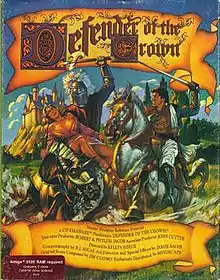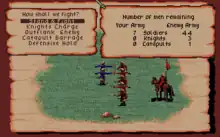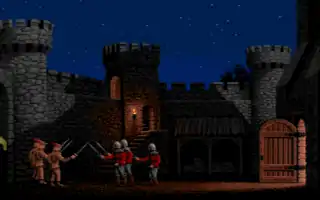Defender of the Crown
Defender of the Crown is a strategy video game designed by Kellyn Beeck. It was Cinemaware's first game, and was originally released for the Commodore Amiga in 1986, setting a new standard for graphic quality in home computer games.
| Defender of the Crown | |
|---|---|
 | |
| Developer(s) | Cinemaware |
| Publisher(s) | Cinemaware |
| Designer(s) | Kellyn Beeck |
| Artist(s) | James D. Sachs |
| Composer(s) | Jim Cuomo |
| Platform(s) | Amiga, C64, Atari ST, MS-DOS, Macintosh, Apple IIGS, Amstrad CPC, ZX Spectrum, NES, CDTV, CD-i, Windows, Game Boy Advance, mobile phone, iOS, Android, Jaguar, Intellivision |
| Release | |
| Genre(s) | Strategy |
| Mode(s) | Single-player |
In 1987 it was ported to MS-DOS, the Atari ST and the Macintosh and a conversion was done for the Commodore 64. Later it was ported to the CDTV, CD-i and Atari Jaguar and conversions were made for the Nintendo Entertainment System (NES), Amstrad CPC, Apple IIGS and Intellivision. Unofficially a ZX Spectrum version was also made. A sequel, Defender of the Crown II, was released in 1993 for the CDTV and Amiga CD32. Two remakes have been released: Robin Hood: Defender of the Crown in 2003 and Defender of the Crown: Heroes Live Forever in 2007.
Gameplay
The game is set in England in 1149 during the Middle Ages where, following the death of the king, different factions are fighting for territorial control.

The player assumes the role of a Saxon (Wilfred of Ivanhoe, Cedric of Rotherwood, Geoffrey Longsword, or Wolfric the Wild) and tries to fight off the Norman hordes and wrestle for control of England. Eventually, the player must fight for control of all territories, and potentially those controlled by other Saxons, if they have become antagonistic. The player must amass armies and fight for control of opponents' castles. The player may engage enemy armies in battle and loot or lay siege to opposing castles. Territories can also be won in the periodic jousting contests. From time to time the player may attempt to rescue a damsel in distress and can appeal for help from the legendary bandit Robin Hood.
The game's strategy boils down to a war of attrition as the player tries to amass larger armies than their opponents and manages to attack their territories at the right time.
Due to financial strains, Cinemaware decided to release the initial version without all the features originally planned for because of their need for revenue. Some features were partially implemented, but were removed so the game could be shipped. Some additional features completed but never seen in the shipped game include flaming fireballs (launched via the catapult), more locations (more varied castles to attack), and more in-depth strategy. Some of these features were implemented in later versions of the game.
James D. Sachs, the primary artist for the game, showcased some of these features on the Amiga during interviews after the release of the game.
Cover art
The cover art of Defender of the Crown was put together by Peter Green Design and painted by Ezra Tucker.
Randy McDonald was in charge of art direction, design, and production for Cinemaware's first four games, and he explains in an interview that "Peter Greene or I would do a sketch of generally what we wanted for each cover. I went to Western Costume in Hollywood, which for many decades was the giant in the costume industry there, and rented costumes for the types of "look" we had settled on for each cover. We hired models and brought them into Peter's large photo studio, where we set them up in the costumes I had rented, posed as closely as possible to the way we wanted them to be illustrated."[2]
The initial artist, according to Randy McDonald, was supposed to be Greg Winter, but the cover eventually went to Ezra Tucker.
Versions
The versions of Defender of the Crown, notably for DOS and the NES, resulted in an enormous loss in graphic and audio quality due to those systems' inferior abilities compared to the Amiga. But these versions featured more in-depth strategic elements compared to the unfinished original version. The Apple IIGS, Atari ST, and Commodore 64 versions were done with better success, the IIGS, Macintosh, and ST versions' graphics coming quite close to the Amiga version. A version for the Sharp X68000 was in development by Bullet-Proof Software but never released.[3]
All versions:
- Amstrad CPC
- Atari ST
- Apple IIGS
- Commodore 64
- Game Boy Advance
- Nintendo Entertainment System
- Macintosh
- DOS CGA (4 color) and EGA (16 color)
- ZX Spectrum (unofficial)
- CD-i
- iOS[4]
- Android[5]
- Atari Jaguar[6]
- Intellivision[7]
In 1989, the game became the second game to ship on CD-ROM, after The Manhole.[8]
Reception
The first public demonstration of Defender of the Crown occurred at the Los Angeles Commodore Show in September 1986, before its November release, and attracted a huge crowd.[9] The game amazed those who saw it for the first time:[10]

Mical saw artist Jim Sachs push the Amiga to its full potential. "Jim Sachs, what a god he is," marvels Mical. "Jim Sachs is amazing. These days everyone sees graphics like that because there are a lot of really good computer graphics artists now, but back then, 20 years ago, it was astonishing to have someone that good."
The final game was a landmark in video game production values. As game designer Bob Lindstrom recalls, "The shock of seeing Defender for the first time was one of those experiences that changed the gaming stakes for all of us."
Compared to other video games of the time, Defender of the Crown established a new level of quality. IBM had Kings Quest by Sierra On-Line, a decent but primitive adventure game. The Macintosh had games like Checkers or Backgammon, or board games like Risk. Defender of the Crown had richer graphics than any computer, console, or even arcade game could boast in 1986. It was a revelation.
Defender of the Crown became a commercial hit. In 1989, Video Games & Computer Entertainment reported that it had been purchased by "almost three-quarters of a million gamers worldwide".[11] Sales had surpassed 1 million units by 2001.[12]
Info gave the Amiga version four stars out of five, stating that its "graphics have set new standards for computer games". The magazine praised the "breathtaking" animation and "impressive" color, but hoped that future Cinemaware games would improve on the "adequate" gameplay, which was "the weak link".[13] The Australian Commodore Review gave the Commodore 64 version of the game a total score of 96 out of 100,[14] while Commodore User said that it was "totally brilliant and one of the best games to date on the 64."[15] Computer Gaming World praised the Amiga version of Defender of the Crown's graphics and animation, calling the game "a showcase program to demonstrate the power of the Amiga to your friends." Although the gameplay was not as complex as other strategy games of the time, the reviewer was still exceptionally pleased with Cinemaware's first game.[16] That year the magazine gave Defender of the Crown a special award for "Artistic Achievement in a Computer Game",[17] but in 1990 and 1993, surveys of wargames in the magazine gave the game two-plus stars out of five.[18][19]
Compute! also stated that Defender of the Crown effectively demonstrated the Amiga's graphics, but stated that its gameplay was oversimplified.[20] CU Amiga stated that "there are not many areas in which Defender of the Crown could be improved ... the graphics are sophisticated with lush colours and visual effects."[21] Amiga Format were less kind to the CD rerelease of the game, stating that it "hasn't stood the test of time simply because the gameplay is somewhat weak."[22][9]
The One magazine in 1991 rated the game four out of five stars for the Amiga, Atari ST and PC.[23] In 1996, Computer Gaming World declared Defender of the Crown the 92nd-best computer game ever released.[24]
Reviews
Legacy
Defender of the Crown II was published by Commodore International in 1993 for the CDTV and Amiga CD32.
After a string of successful games and game series, Cinemaware eventually went bankrupt. In 2000, however, Lars Fuhrken-Batista and Sean Vesce bought Cinemaware's name and assets, and founded Cinemaware Inc., naming a remake of Defender of the Crown for modern PCs as one of the reformed company's first projects. The new version, titled Robin Hood: Defender of the Crown was released in 2003 for the PlayStation 2 (September 30), Xbox (October 6), and Windows (October 15). The new company also created "Digitally Remastered Versions" of classic Cinemaware games, including Defender of the Crown.
In February 2007, a second remake to the game called Defender of the Crown: Heroes Live Forever was released by eGames,[26] who had acquired Cinemaware in 2005. Heroes Live Forever features many of the elements of the original game, including jousting and archery tournaments, raiding castles, rescuing princesses, and laying siege to enemy fortresses via catapult. A new addition to the game involved the use of Hero and Tactic cards during battles, giving the user's army various upgrades during the on-screen melee.
During the second half of the 1980s, some games directly inspired by Defender of the Crown were released. Among these was for example Joan of Arc (Rainbow Arts, 1989).
The Danish band PRESS PLAY ON TAPE remixed the theme music of the game on their 2003 album Run/Stop Restore, replacing the instrumental tune with proper medieval-sounding lyrics.[27]
References
- "Defender of the Crown (Registration Number VA0001257939)". United States Copyright Office. Retrieved 5 July 2021.
- This is how the cover art in Defender of the Crown was made - Spelpappan.se
- "BPSの話". jester.dw.land.to (in Japanese). Archived from the original on 2016-08-24. Retrieved 2020-04-01.
- "Defender of the Crown iOS". Archived from the original on 2011-11-26. Retrieved 2011-11-27.
- "Cinemaware Classic Defender of the Crown Ready for Android". Archived from the original on 2016-07-16. Retrieved 2014-04-26.
- "Defender of the Crown et Treasure Island Dizzy sur Atari Jaguar !". 21 September 2018.
- "Defender of the Crown - All time classic game by Cinemaware is coming to the Intellivision!".
- Sipe, Russell (November 1992). "3900 Games Later ..." Computer Gaming World. p. 8. Retrieved 4 July 2014.
- Maher, Jimmy (2015-04-16). "Defender of the Crown". The Digital Antiquarian. Retrieved 16 April 2015.
- On the edge : the spectacular rise and fall of Commodore from WorldCat.org
- Worley, Joyce (December 1989). "Mega Hits: The Best of the Best". Video Games & Computer Entertainment: 130–132, 137, 138.
- Hill, Mark (January 2001). "Cinemaware Return from the Dead". PC Zone (98): 30.
- Dunnington, Benn; Brown, Mark R.; Malcolm, Tom (January–February 1987). "Amiga Gallery". Info. pp. 90–95.
- Gordon, Stephen; Watts, Shane (February 1987), "Defender of the Crown - page scan at Amiga Magazine Rack, issue 2, accessed December 18, 2012
- Patterson, Mark (August 1987) "Defender of the Crown" - page scan at Amiga Magazine Rack, accessed December 18, 2012.
- Lee, Wyatt (January–February 1987). "Defender of the Crown". Computer Gaming World. pp. 36–37, 68–69.
- "Computer Gaming World Meets Dragoncon '87". Computer Gaming World. No. 42. December 1987. p. 62. Retrieved 23 April 2016.
- Brooks, M. Evan (October 1990). "Computer Strategy and Wargames: Pre-20th Century". Computer Gaming World. p. 11. Retrieved 16 November 2013.
- Brooks, M. Evan (August 1993). "Wargame Survey Version 2.0". Computer Gaming World. p. 128. Retrieved 12 July 2014.
- Randall, Neil (June 1987). "Defender Of The Crown For Amiga". Compute!. No. 85. p. 60. Retrieved 10 November 2013.
- Keating, Fiona (July 1991), "Defender of the Crown" - page scan at Amiga Magazine Rack, accessed December 18, 2012
- Noonan, Damien (October 1992) "Defender of the Crown - page scan at Amiga Magazine Rack, issue 39, accessed December 18, 2012
- Presley, Paul (28 March 1991). "The Price is Right". The One. No. 31 (April 1991). EMAP Images. pp. 80–1.
- Staff (November 1996). "150 Best (and 50 Worst) Games of All Time". Computer Gaming World. No. 148. pp. 63–65, 68, 72, 74, 76, 78, 80, 84, 88, 90, 94, 98.
- "Defender of the Crown". Jeux & stratégie (in French). No. 47. October 1987. p. 62.
- Defender of the Crown: Heroes Live Forever Archived 2008-04-05 at the Wayback Machine from eGames
- "CDs". Press Play On Tape. Retrieved 7 May 2018.
External links
- Defender of the Crown at MobyGames
- Defender of the Crown at Curlie
- Defender of the Crown on the Amiga at The Hall of Light (HOL)
- Images of Defender of the Crown box, manual and screen shots at C64Sets.com
- Panda's Defender of the Crown page
- https://web.archive.org/web/20160619205027/http://www.thelegacy.de/Museum/game.php3?titel_id=4073&game_id=4108
- Legally distributed recordings of the Amiga version music
- Macintosh Plus game gallery featuring DotC screenshots
- Review in Isaac Asimov's Science Fiction Magazine